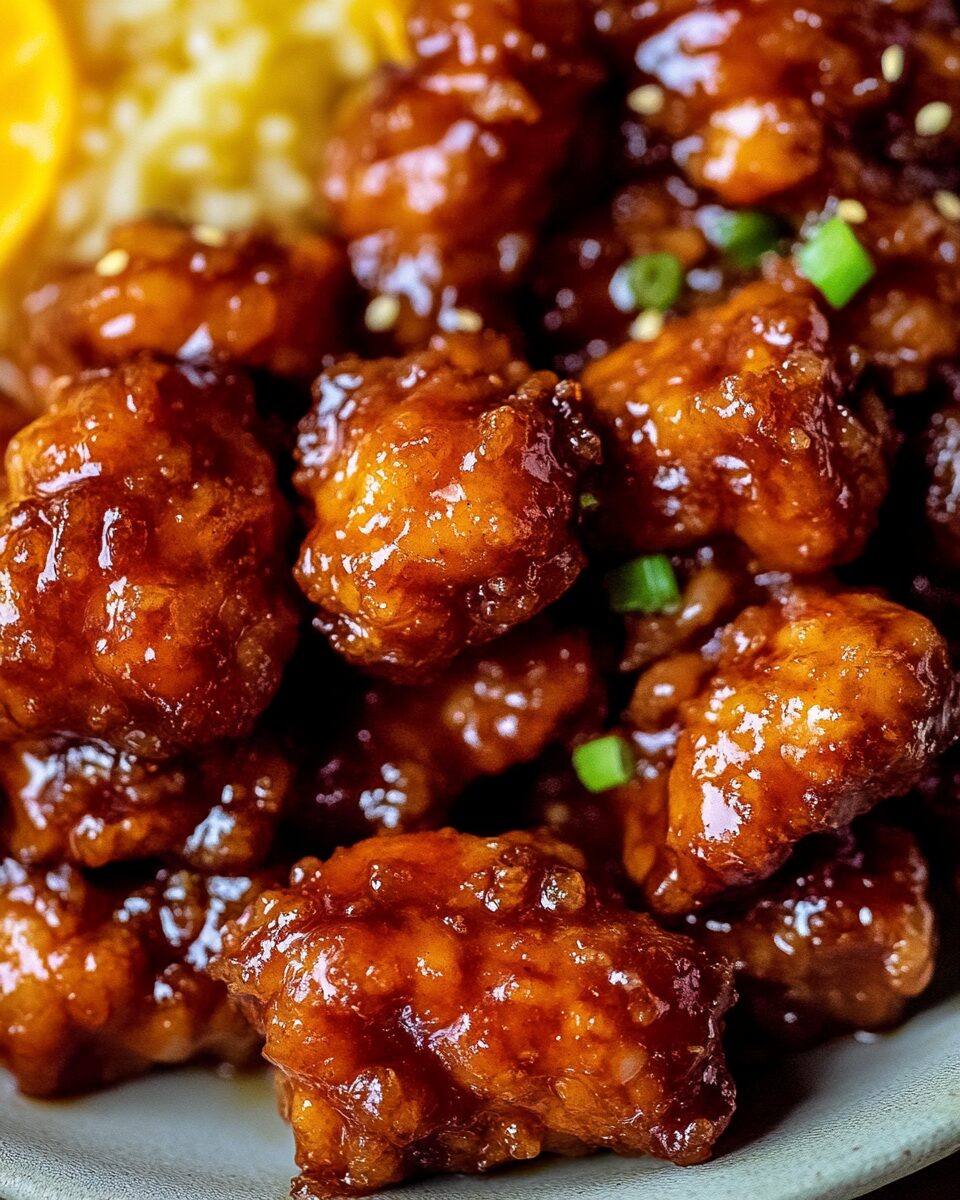This homemade Orange Chicken offers a crispy, tender bite enveloped in a tangy, sweet sauce. Inspired by popular Chinese takeout dishes, it’s an easy and flavorful meal perfect for any occasion.
FULL RECIPE
Ingredients
- 90 g (3/4 cup) plain (all-purpose) flour
- 1 medium egg
- ¼ tsp garlic salt
- Pinch of salt and pepper
- 90 ml (1/3 cup + 1 tbsp) cold water
- 8 chicken thigh fillets (skinless and boneless), chopped into bite-size chunks
- 2 tbsp cornflour (cornstarch)
- 120 ml (1/2 cup) vegetable oil for frying
1.For the Orange Sauce:
- Zest of ½ an orange
- Juice of 2 oranges
- 2 tbsp soy sauce
- 2 cloves garlic, minced
- 1 tsp grated fresh ginger
- 2 tbsp sugar
- 1 tbsp rice vinegar
Directions
- In a bowl, whisk together the flour, egg, garlic salt, salt, pepper, and cold water to create a smooth batter.
- In a separate bowl, toss the chicken pieces with cornflour until evenly coated.
- Dip each piece of chicken into the batter, ensuring it’s fully coated.
- Heat the vegetable oil in a wok or large frying pan over medium-high heat.
- Fry the battered chicken pieces in batches, cooking until golden brown and crispy, about 4-5 minutes per batch.
- Remove the cooked chicken from the oil and set aside on a paper towel-lined plate to drain excess oil.
- Carefully discard the excess oil from the pan, leaving about 1 tablespoon.
- Add the orange zest, orange juice, soy sauce, garlic, ginger, sugar, and rice vinegar to the pan.
- Bring the sauce to a simmer over medium heat, stirring occasionally, until it thickens slightly, about 3-4 minutes.
- Return the fried chicken to the pan, tossing to coat each piece in the sauce.
- Cook for an additional 2-3 minutes, allowing the chicken to absorb the flavors.
- Serve the Orange Chicken over steamed rice, garnished with sesame seeds if desired.
Nutritional Information
- Calories: 450 kcal
- Protein: 30 g
- Carbohydrates: 40 g
- Fat: 20 g
- Fiber: 2 g
- Sodium: 800 mg
The Origins of Orange Chicken
Orange Chicken is a beloved dish that traces its roots to Chinese-American cuisine. It is often associated with Chinese takeout, but it was actually created in the U.S. The recipe is a fusion of Chinese cooking techniques and American flavor preferences, notably the use of sweet, tangy, and savory ingredients to create a dish that appeals to a wide range of tastes.
The Influence of Chinese-American Cuisine
Chinese-American cuisine has evolved significantly over the decades. Many dishes, like Orange Chicken, are adaptations of traditional Chinese recipes made to suit American palates. The incorporation of sweet sauces, such as orange glaze, is a hallmark of this cuisine. These flavors cater to a preference for bolder, sweeter sauces, contrasting with more subtle flavors often found in traditional Chinese cooking.
The Importance of the Sauce
The key element that differentiates Orange Chicken from other chicken dishes is the sauce. The vibrant and aromatic orange sauce is tangy with a touch of sweetness, balanced by the umami from soy sauce and a slight hint of spice from ginger and garlic. This sauce envelops the crispy chicken, providing a delightful contrast of textures and flavors. The sauce is what makes the dish unique and adds its signature bright, citrusy flavor.
Variations of Orange Chicken Around the World
Although Orange Chicken is often considered an Americanized dish, it has many variations around the world. In Canada, it’s a popular menu item in Chinese-Canadian restaurants, while in the United Kingdom, it’s a staple in Chinese takeaway spots. Each region may have subtle differences in the sauce, sometimes adding chili for spice or using other citrus fruits like tangerines.
Crispy Chicken for the Perfect Texture
One of the most important aspects of this dish is the texture of the chicken. The chicken is first battered and fried, achieving a crispy exterior that contrasts beautifully with the tender meat inside. The crispiness is a key factor in ensuring that the chicken holds up well against the sauce and doesn’t become soggy.
The Role of Cornstarch in the Coating
Cornstarch plays a vital role in the batter used for Orange Chicken. It helps to create a light, crispy crust that doesn’t absorb too much oil. Cornstarch is often mixed with flour in many Chinese dishes to give a delicate texture to fried foods. This results in a satisfying crunch when you bite into the chicken, providing a perfect contrast to the juicy interior and the rich sauce.
The Benefits of Using Chicken Thighs
Chicken thighs are typically used in Orange Chicken because of their tender and juicy nature. They have more fat compared to chicken breasts, which helps retain moisture during frying. The dark meat of the thigh also adds a richer flavor, making it a perfect choice for this dish. Using thighs ensures that the chicken remains succulent even after being battered and fried.
The Sweet and Savory Flavor Profile
Orange Chicken is known for its complex flavor profile. The sauce combines sweet elements from the sugar and orange juice, with savory components from the soy sauce. The garlic and ginger add an aromatic depth to the dish, making it a balanced experience of contrasting tastes. The combination of sweet and savory flavors makes Orange Chicken universally appealing.
Why Orange is the Best Citrus for This Dish
The choice of orange as the main citrus ingredient in the sauce is essential. Oranges provide a natural sweetness that balances the savory flavors of soy sauce and the heat of ginger. The zest of the orange also enhances the aromatic quality of the sauce, contributing both flavor and fragrance to the dish. Other citrus fruits, such as lemons or limes, would not give the same depth of sweetness that oranges provide.
How to Make the Sauce Perfect Every Time
The key to a perfect Orange Chicken sauce lies in balancing the ingredients. It’s crucial to let the sauce simmer until it thickens slightly, allowing the flavors to meld. Cooking the sauce too quickly can result in a runny texture, while overcooking can cause it to become too thick or bitter. The trick is to simmer on low heat while stirring constantly, ensuring a smooth, glossy finish.
Pairing Orange Chicken with Side Dishes
Orange Chicken is a versatile dish that pairs well with many sides. Traditionally, it is served over steamed white rice, which absorbs the sauce beautifully. For a more colorful presentation, you can serve it with fried rice, sautéed vegetables, or a simple stir-fry. Steamed broccoli or bok choy can also complement the dish, offering a fresh and crunchy contrast to the richness of the chicken.
Orange Chicken as a Party Dish
Due to its combination of flavors and textures, Orange Chicken makes for an excellent party dish. It can be served as a main course or as part of a larger spread of appetizers. The individual pieces of crispy chicken make it easy for guests to grab and enjoy, and the sweet, savory sauce ensures that everyone will love it.
Adjusting the Spice Level
If you enjoy a bit of heat in your Orange Chicken, it’s easy to adjust the spice level. Adding a pinch of red pepper flakes or a bit of chili paste to the sauce will introduce an extra layer of spice. The heat balances out the sweetness of the orange sauce, creating a more complex flavor profile that suits those who enjoy spicy food.
Orange Chicken for Meal Prep
Orange Chicken can also be a great choice for meal prep. The chicken can be fried and stored separately from the sauce, keeping its crispy texture intact. When ready to serve, simply reheat the chicken and toss it in the freshly made sauce. This ensures that you can enjoy this dish throughout the week, with minimal effort required to prepare it each time.
Healthier Alternatives to the Traditional Recipe
While Orange Chicken is delicious, it can be quite high in calories due to the frying process. For a healthier alternative, you can bake the chicken instead of frying it. Coating the chicken in a light batter or using less oil can help reduce the overall fat content. Another option is to substitute some of the sugar in the sauce with a natural sweetener like honey or maple syrup.
The Popularity of Orange Chicken in Fast Food Chains
Orange Chicken is not just popular in restaurants; it has also made its way into fast-food chains, most notably Panda Express. The chain’s version of Orange Chicken has gained a cult following, with many fans praising its combination of crunchy chicken and flavorful sauce. This widespread popularity has made the dish one of the most recognizable items in Chinese-American fast food.
Vegan and Vegetarian Variations
For those who follow a plant-based diet, it’s possible to make a vegan or vegetarian version of Orange Chicken. Instead of chicken, tofu or tempeh can be used as a substitute. The tofu can be pressed and fried to achieve a similar texture to the traditional chicken. The sauce can remain the same, offering the same tangy sweetness that makes Orange Chicken so appealing.
The Versatility of Orange Sauce
The orange sauce used in this recipe is not limited to just chicken. It can be used to coat other proteins such as shrimp, pork, or even tofu. The sauce can also be drizzled over vegetables like roasted carrots or sweet potatoes, offering a sweet and savory kick to your meals. The versatility of the sauce makes it an excellent condiment to keep on hand for a variety of dishes.
How to Store Leftover Orange Chicken
Leftover Orange Chicken can be stored in an airtight container in the refrigerator for up to three days. However, to maintain the crispy texture of the chicken, it is best to store the sauce separately. When reheating, you can reheat the chicken in an oven to restore its crunch and then toss it in the sauce before serving.
Conclusion
Orange Chicken is a delightful dish that has earned its place as a favorite in Chinese-American cuisine. The combination of crispy chicken and sweet, tangy sauce creates a harmonious flavor profile that is loved by many. Whether enjoyed at a restaurant, prepared at home, or as part of a meal prep routine, Orange Chicken continues to be a versatile and satisfying dish. Its popularity speaks to its universal appeal, and with a few simple tweaks, it can be adapted to suit a variety of tastes and dietary preferences.






